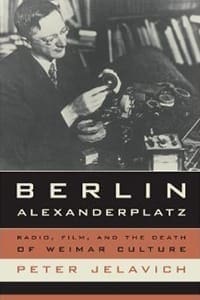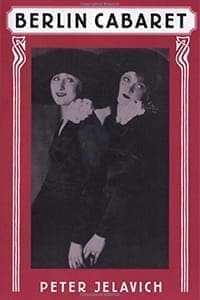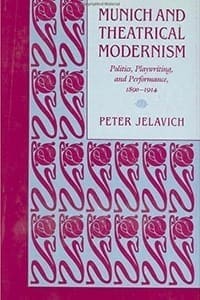
Peter Jelavich
Professor
Contact Information
- [email protected]
- Curriculum Vitae
- Gilman 370
Research Interests: Cultural and intellectual history of Europe since the Enlightenment, with emphasis on Germany, popular culture, mass culture, and the media, and modern social and cultural theory
Education: PhD, Princeton University
Peter Jelavich specializes in the cultural and intellectual history of Europe since the Enlightenment, with emphasis on Germany. His areas of interest include the interaction of elite and popular culture; the history of mass culture and the media; and censorship of arts and ideas.
He is the author of Munich and Theatrical Modernism: Politics, Playwriting, and Performance, 1890-1914 (1985), Berlin Cabaret (1993), Berlin Alexanderplatz: Radio, Film, and the Death of Weimar Culture (2006), and Kunstfreiheit: Eine deutsche Ideologie. Vom Naturalismus bis zur documenta 15 (2025).
He currently is writing a book on censorship of the arts in Germany from 1890 to the present.
“ ‘Wiederjudmachung’: Jüdischer Humor in der Bundesrepublik Deutschland.” In: Jörg Requate and Carina Gabriel-Kinz, eds., Lachen und Verlachen: Komik und Satire in gesellschaftlichen Auseinandersetzungen seit dem ausgehenden 19. Jhrhundert. Stuttgart: Franz Steiner Verlag, 2025.Pp. 79-94.
“Kunstfreiheit: Eine deutsche Ideologie.” In: Winfried Nerdinger, ed., Grenzen der Kunstfreiheit? Göttingen: Wallstein Verlag, 2024. Pp. 163-191.
“Pan(dem)izza: Panizza lesen in der Pandemie.” In: Jahrbuch der Freunde der Monacensia 2021. Pp. 169-180.
“Am Anfang war Panizza.” In: Herzattacke 100 (2018): 94-99.
“Terror of the Soul.” Berlin: 2018. 29 pp. [Separately bound essay, in artist book edition of Edgar Allen Poe’s “The Raven”, three volumes + portfolio, illustrations by Felix Martin Furtwängler and photographs by Peter Jelavich.]
“Popular Entertainment and Mass Media: The Central Arenas of German-Jewish Cultural Engagement.” In: Steven Aschheim and Vivian Liska, eds., The German-Jewish Experience Revisited. Berlin: de Gruyter, 2015. Pp. 103-116.
“Kunstfreiheit = Impotenz der Kunst?” In: York-Gothart Mix, ed., Kunstfreiheit und Zensur in der Bundesrepublik Deutschland. Berlin: de Gruyter, 2014. Pp. 119-131.
“Maschinenmenschen: Mediale Massenbildung bei Alfred Döblin.” In: Stefan Keppler-Tasaki, ed., Massen und Medien bei Alfred Döblin: Internationales Alfred-Döblin-Kolloquium 2011. Bern: Peter Lang, 2014. Pp. 251-274.
“When Are Jewish Jokes No Longer Funny? Ethnic Humour in Imperial and Republican Berlin.” In: Martina Kessel and Patrick Merzinger, eds., The Politics of Humour: Laughter, Inclusion, and Exclusion in the Twentieth Century. Toronto: University of Toronto Press, 2012. Pp. 22-51.
“Döblins Moderne.” Internationales Archiv für Sozialgeschichte der deutschen Literatur, vol. 37, no. 1, 2012, pp. 119-127.
“Nietzsches ‘guter’ (und antitheatralischer) Europäer.” In: Erika Fischer-Lichte, Matthias Warstatt and Anna Littmann, eds., Theater und Fest in Europa: Perspektiven von Identität und Gemeinschaft. Tübingen: Francke Verlag, 2012. Pp. 305-323.
“Dance of Life, Dance of Death.” In: Starr Figura, ed., German Expressionism: The Graphic Impulse. New York: Museum of Modern Art, 2011. Pp. 36-51.
“Wie ‘jüdisch’ war das Theater im Berlin der Jahrhundertwende?” In: Tobias Becker, Anna Littmann, and Johanna Niedbalski, eds., Die tausend Freuden der Metropole: Vergnügnungskultur um 1900 . Bielefeld: transcript Verlag, 2011. Pp. 87-104 [=translation and revision of following article].
“How ‘Jewish’ was Theatre in Imperial Berlin?” In: Jeanette Malkin and Freddie Rokem, eds., Jews and the Making of Modern German Theatre. Iowa City: University of Iowa Press, 2010. Pp. 39-58.
“What’s Wrong with Fragmentation?” Internationales Archiv für Sozialgeschichte der deutschen Literatur, vol. 34, no. 2, 2009, pp. 217-221.
“ ‘Die Welt würde die Bücher nicht fassen, die zu schreiben wären’: Geschichte zwischen Logos und Logorrhoe.” In: Martin Baumeister, Moritz Föllmer, and Philipp Müller, eds., Die Kunst der Geschichte: Historiographie, Ästhetik, Erzählung. Göttingen: Vandenhoeck & Ruprecht, 2009. Pp. 13-27.
“Die ‘Elf Scharfrichter’: Ein Münchener Vorbild für das Kabarett Fledermaus.” In: Michael Buhrs, Barbara Lesak, and Thomas Trabitsch, eds., Kabarett Fledermaus 1907 bis 1913: Ein Gesamtkunstwerk der Wiener Werkstätte: Literatur, Musik, Tanz. Vienna: Christian Brandstätter Verlag, 2007. Pp. 17-29.
“Cultural History.” In: Gunilla Budde, Sebastian Conrad, and Oliver Janz, eds., Transnationale Geschichte: Themen, Tendenzen und Theorien. Göttingen: Vandenhoeck & Ruprecht: 2006. Pp. 227-237.
“Grotesque and Carnivalesque: Negation and Renewal around 1900.” In: Pamela Kort, ed., Comic Grotesque: Wit and Mockery in German Art, 1870-1940. Munich: Prestel, 2004. Pp. 89-104 [=translation of following article].
“Grotesk und karnevalesk: Negation und Erneuerung um 1900.” In: Pamela Kort, ed., Grotesk! 130 Jahre Kunst der Frechheit. Munich: Prestel, 2003. Pp. 79-89.
“The City Vanishes: Piel Jutzi’s Berlin Alexanderplatz (1931).” In: Mark Shiel and Tony Fitzmaurice, eds., Screening the City. London: Verso, 2003. Pp. 58-79.
“Der demokratische Giftschrank: Zensur und Indizierung in der Weimar Republik und der Bundesrepublik.” In: Stephan Kellner, ed., Der ‘Giftschrank’: Erotik, Sexualwissenschaft, Politik und Literatur—‘REMOTA”: Die weggesperrten Bücher der Bayerischen Staatsbibliothek. Munich: Bayerische Staatsbibliothek, 2002. Pp. 56-67.
[in Hebrew:] “Free to Destroy Freedom? Hate Speech in the Weimar Republic.” In: Michael Confino, ed., The Power of Words and the Frailty of Reason: Propaganda, Incitement and Freedom of Speech. Tel Aviv: Am Oved Publishers, 2002. Pp.181-199.
“Satire under Socialism: Cabaret in the German Democratic Republic.” In: Sigrid Bauschinger, ed., Die freche Muse / The Impudent Muse. Tübingen: Francke Verlag, 2000. Pp. 163-178.
“ ‘Am I Allowed to Amuse Myself Here?’: The German Bourgeoisie Confronts Early Film.” In: Suzanne Marchand and David Lindenfeld, eds., Germany at the Fin de Siècle: Culture, Politics, and Ideas. Baton Rouge: Louisiana State University Press, 2004. Pp. 227-249 [=translation of following article].
“ ‘Darf ich mich hier amüsieren?’ Bürgertum und früher Film.” In: Manfred Hettling and Stefan-Ludwig Hoffmann, eds., Der bürgerliche Wertehimmel: Innenansichten des 19. Jahrhunderts. Göttingen: Vandenhoeck & Ruprecht, 2000. Pp. 283-303.
“Paradoxes of Censorship in Modern Germany.” In: Mark Micale and Robert Dietle, eds., Enlightenment, Passion, Modernity: Historical Essays in European Thought and Culture. Stanford: Stanford University Press, 2000. Pp. 265-285.
“Performing High and Low: Jews in Theater, Cabaret, Revue, and Film.” In: Emily Bilski, ed., Berlin Metropolis: Jews and the New Culture, 1890-1918. New York: The Jewish Museum, 1999. Pp. 208-235.
“German Culture in the Great War.” In: Aviel Roshwald and Richard Stites, eds., European Culture in the Great War. Cambridge: Cambridge University Press, 1999. Pp. 32-57.
“Literature and the Arts.” In: Roger Chickering, ed., Imperial Germany: A Historiographical Companion. Westport: Greenwood Press, 1996. Pp. 377-408.
“The ‘Wrapped Reichstag’: From Political Symbol to Artistic Spectacle.” German Politics and Society, vol. 13, no. 4, Winter 1995, pp. 110-127.
“Methode? Welche Methode? Bekenntnisse eines gescheiterten Strukturalisten.” In: Christoph Conrad and Martina Kessel, eds., Kultur und Geschichte: Neue Einblicke in eine alte Beziehung. Stuttgart: Reclam, 1998. Pp. 141-159 [=translation of following article].
“Method? What Method? Confessions of a Failed Structuralist.” New German Critique, no. 95, Spring/Summer 1995, pp. 75-86.
“Poststrukturalismus und Sozialgeschichte—aus amerikanischer Perspektive.” Geschichte und Gesellschaft, vol. 21, no. 2, April 1995, pp. 259-289.
“A berlini kabaré mint a metropolisz-lét montázsa.” Budapesti Negyed, Spring 1995, pp. 72-102 [=chapter 1 of Berlin Cabaret].
“German Culture in a Modern World.” In: James Harris and Fay Metcalf, eds., Germany and Europe since World War II: Resources for Teachers. Bloomington: Educational Resources Information Center, 1994. Pp. 69-83.
“ ‘Girls and Crisis’: The Political Aesthetics of the Kickline in Weimar Berlin.” In: Michael Roth, ed., Rediscovering History: Culture, Politics, and the Psyche. Stanford: Stanford University Press, 1994. Pp. 224-239.
“Paradoxien der Zensur im Deutschland des 20. Jahrhunderts.” Potsdamer Bulletin für Zeithistorische Studien, no. 1, August 1994, pp. 16-26.
“Metamorphoses of Censorship in Modern Germany.” German Politics and Society, no. 27, fall 1992, pp. 25-35.
“Populäre Theatralik, Massenkultur und Avantgarde: Betrachtungen zum Theater der Jahrhundertwende.” In: Herta Schmid and Jurij Striedter, eds., Dramatische und theatralische Kommunikation: Beiträge zur Geschichte und Theorie des Dramas und Theaters im 20. Jahrhundert. Tübingen: Gunter Narr Verlag, 1992. Pp. 253-261.
“Kulturgeschichtliche Bemerkungen zur Berlin-Historiographie.” In: Konrad Jarausch, ed., Zwischen Parteilichkeit und Professionalität: Bilanz der Geschichtswissenschaft in der DDR. Berin: Akademie Verlag, 1991. Pp. 107-121.
“The Limits of Political Satire: Cabaret in the Weimar Republic and the Federal Republic.” In: Ursula Hoffmann-Lange, ed., Social and Political Structures in West Germany: From Authoritarianism to Postindustrial Democracy. Boulder: Westview Press, 1991. Pp. 175-186.
“ Modernity, Civic Identity, and Metropolitan Entertainment: Vaudeville, Cabaret and Revue in Berlin, 1900-1933.” In: Charles W. Haxthausen and Heidrun Suhr, eds., Berlin: Culture and Metropolis. Minneapolis: University of Minnesota Press, 1990. Pp. 95-110.
“Authorial Games: Confronting Censorship and the Market.” In: Karin MacHardy and Gisela Brude-Firnau, eds., Fact and Fiction: German History and Literature 1848-1924. Tübingen: Francke Verlag, 1990. Pp. 69-75.
“Contemporary Literary Theory: From Deconstruction Back to History.” Central European History, vol. 22, no. 3/4, September/December 1989, pp. 360-380.
“Berlin's Path to Modernity.” In: Art in Berlin 1815-1989. Atlanta: High Museum of Art, 1989. Pp. 13-40.
“Cabarets in Berlin, 1901-1944.” In: Marc Ferro and Sheila Fitzpatrick, eds., Culture et révolution. Paris: Editions de l'Ecole des Hautes Etudes en Sciences Sociales, 1989. Pp. 91-103.
“Republican Ethics as Social Science: The Case of Emile Durkheim.” In: Murray Milgate and Cheryl Welch, eds., Critical Issues in Social Thought. London: Academic Press, 1989. Pp. 139-157.
“Cabaret and the Dilemma of Satire in the Early Weimar Republic.” In: Gerhard Kirchhoff, ed., Views on Berlin. Boston: Birkhäuser, 1989. Pp. 69-79.
“ ‘Nach Moskau! Nach Moskau!’: Three Faces of Three Sisters in Berlin.” German Politics and Society, no. 17, summer 1989, pp. 61-70.
“The Berlin Jubilee: Which History to Celebrate?” German Politics and Society, no. 12, October 1987, pp. 11-17.
“Fabricated Berliners: Identity-Formation in Cabarets and Revues, 1901-1933.” German Politics and Society, no. 12, October 1987, pp. 17-24.
“Satiriker in der Sackgasse: Das Berliner Kabarett der Weimarer Ära.” Wissenschaftskolleg zu Berlin, Jahrbuch 1984/85. Berlin: Siedler Verlag, 1986. Pp. 71-84.
“Berlin and the 20th Century: The Century's History as Seen from Berlin and Reflected in its Experience.” Report from Aspen Institute Berlin, no. 2/85. 14pp.
“The Censorship of Literary Naturalism, 1890-1895: Bavaria.” Central European History, vol. 18, no. 3-4, September-December 1985, pp. 344-359.
“Wedekind’s Spring Awakening: The Path to Expressionist Drama.” In: Stephan Bronner and Douglas Kellner, eds., Passion and Rebellion: The Expressionist Heritage. South Hadley: J.F. Bergin Publishers, 1983. Pp. 129-150.
“Popular Dimensions of Modernist Elite Culture: The Case of Theater in fin de siècle Munich.” In: Dominick LaCapra and Steven Kaplan, eds., Modern European Intellectual History: Reappraisals and New Perspectives. Ithaca: Cornell University Press, 1982. Pp. 220-250.
“München als Kulturzentrum: Politik und die Künste.” In: Armin Zweite, ed., Kandinsky und München: Begegnungen und Wandlungen 1896-1914. Munich: Prestel-Verlag, 1982. Pp. 17-26 [=translation of following article].
“Munich as Cultural Center: Politics and the Arts.” In: Kandinsky in Munich 1896-1914. New York: The Solomon R. Guggenheim Museum, 1982. Pp. 17-26.
“ ‘Die Elf Scharfrichter’: The Political and Sociocultural Dimensions of Cabaret in Wilhelmine Germany.” In: Gerald Chapple and Hans Schulte, eds., The Turn of the Century: German Literature and Art 1890-1915. Bonn: Bouvier-Verlag, 1981. Pp. 507-525.
“Art and Mammon in Wilhelmine Germany: The Case of Frank Wedekind.” Central European History, vol. 12, no. 3, September 1979, pp. 203-236.
“Marché culturel, radicalisation idéologique et innovation esthétique dans le théâtre munichois fin de siècle: Thoma, Wedekind, Fuchs.” Le Mouvement social, no. 109, October-December 1979, pp. 35-65.

Kunstfreiheit: Eine deutsche Ideologie. Vom Naturalismus bis zur documenta fifteen
author
Klostermann/Nexus ,
2025

Berlin Alexanderplatz: Radio, Film, and the Death of Weimar Culture
author
University of California Press ,
2006

Berlin Cabaret
author
Harvard University Press ,
1993

Munich and Theatrical Modernism: Politics, Playwriting, and Performance, 1890-1914
author
Harvard University Press ,
1985